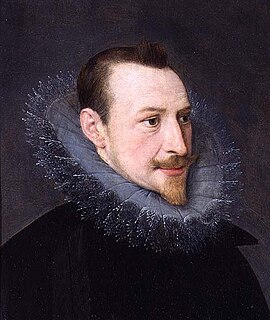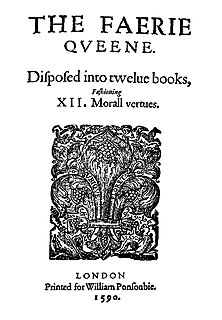This article includes a list of general references, but it lacks sufficient corresponding inline citations .(June 2010) |
Stephen Hawes (died 1523) was a popular English poet during the Tudor period who is now little known.[ citation needed ]
This article includes a list of general references, but it lacks sufficient corresponding inline citations .(June 2010) |
Stephen Hawes (died 1523) was a popular English poet during the Tudor period who is now little known.[ citation needed ]
He was probably born in Suffolk when the surname was common. If his own statement of his age may be trusted, he was born about 1474. He was educated at Oxford and travelled in England, Scotland and France. On his return his various accomplishments, especially his most excellent vein in poetry, procured him a place at court. He was Groom of the Chamber to Henry VII as early as 1502. According to Anthony Wood, he could repeat by heart the works of most of the English poets, especially the poems of John Lydgate, whom he called his master. [1] He was still living in 1521, when it is stated in Henry VIII's household accounts that £6, 13s. 4d. was paid to Mr Hawes for his play; he died before 1530, when Thomas Field, in his Conversation between a Lover and a Jay, wrote "Yong Steven Hawse, whose soule God pardon, Treated of love so clerkly and well".
Some critics, notably C.S. Lewis, have treated Hawes dismissively: "faculty was what he lacked; there was more and better poetry in him than he could express", referring to his "broken-backed metre and dull excursions into the seven liberal arts". [2] But his metre is not consistently broken-backed: from time to time (though not very often) one encounters lines that would not have disgraced either Chaucer before him or Spenser after him: "The fragraunt fumes / dyde well encense out // All mysty vapours / of perturbacyon // ore lyker was / her habytacyon // Vnto a place / whiche is celestyall // Than to a terrayne / mancyon fatall" or "By her propre hande / soft as ony sylke // With due obeysaunce / I dyde her than take // Her skynne was whyte / as whalles bone or mylke // My thoughtes was rauysshed / I myght not aslake // My brennynge hert / she the fyre dyde make // These daunces truely / musyke hath me tought // To lute or daunce / but it auayled nought" and so on, where, so long as one pronounces at least some of the final e's, the metre seems to work quite well.
Novelist Hilda Lamb made Hawes a character of her novel "The Willing Heart" published in 1958, where he is fictionally portrayed as an illegitimate son of King Richard III's. [3] No contemporary documents support this assumption.
This article needs additional citations for verification .(May 2020) |
His major work is The History of Graunde Amour and la Bel Pucel, conteining the knowledge of the Seven Sciences and the Course of Mans Life in this Worlde or The Passetyme of Pleasure, printed by Wynkyn de Worde in 1509, but finished three years earlier. It was also printed with slightly varying titles by the same printer in 1517, by J. Wayland in 1554, by Richard Tottel and by John Waley in 1555. Tottel's edition was edited by T. Wright and reprinted by the Percy Society in 1846.
The Passetyme of Pleasure is a long allegorical poem in seven-lined stanzas of man's life in this world. It is divided into sections after the manner of Le Morte d'Arthur and borrows the machinery of romance. Its main motive is the education of the knight, Graunde Amour, based, according to William John Courthope (History of English Poetry, vol. I. 382), on the Marriage of Mercury and Philology, by Martianus Capella, and the details of the description prove Hawes to have been acquainted with medieval systems of philosophy. At the suggestion of Fame, and accompanied by her two greyhounds, Grace and Governance, Graunde Amour starts out in quest of La Bel Pucel. He first visits the Tower of Doctrine or Science where he acquaints himself with the arts of grammar, logic, rhetoric and arithmetic. After a long disputation with the lady in the Tower of Music he returns to his studies, and after sojourns at the Tower of Geometry, the Tower of Doctrine, the Castle of Chivalry, etc., he arrives at the Castle of La Bel Pucel, where he is met by Peace, Mercy, Justice, Reason and Memory. His happy marriage does not end the story, which goes on to tell of the oncoming of Age, with the concomitant evils of Avarice and Cunning. The admonition of Death brings Contrition and Conscience, and it is only when Remembraunce has delivered an epitaph chiefly dealing with the Seven Deadly Sins, and Fame has enrolled Graunde Amours name with the knights of antiquity, that we are allowed to part with the hero. This long imaginative poem was widely read and esteemed, and certainly exercised an influence on the genius of Edmund Spenser.
Hawes' poetry sought to revive the earlier medieval romances and allegorical poems which he much admired. Other works of Hawes include The Conversyon of Swerers (1509) and A Joyfidi Medytenon to all Englonde, a coronation poem (1509).

As a literary device or artistic form, an allegory is a narrative or visual representation in which a character, place, or event can be interpreted to represent a hidden meaning with moral or political significance. Authors have used allegory throughout history in all forms of art to illustrate or convey complex ideas and concepts in ways that are comprehensible or striking to its viewers, readers, or listeners.

Edmund Spenser was an English poet best known for The Faerie Queene, an epic poem and fantastical allegory celebrating the Tudor dynasty and Elizabeth I. He is recognized as one of the premier craftsmen of nascent Modern English verse and is often considered one of the greatest poets in the English language.

Sir Thomas Wyatt was a 16th-century English politician, ambassador, and lyric poet credited with introducing the sonnet to English literature. He was born at Allington Castle near Maidstone in Kent, though the family was originally from Yorkshire. His family adopted the Lancastrian side in the Wars of Roses. His mother was Anne Skinner, and his father Henry, who had earlier been imprisoned and tortured by Richard III, had been a Privy Councillor of Henry VII and remained a trusted adviser when Henry VIII ascended the throne in 1509. Thomas followed his father to court after his education at St John's College, Cambridge. Entering the King's service, he was entrusted with many important diplomatic missions. In public life his principal patron was Thomas Cromwell, after whose death he was recalled from abroad and imprisoned (1541). Though subsequently acquitted and released, shortly thereafter he died. His poems were circulated at court and may have been published anonymously in the anthology The Court of Venus during his lifetime, but were not published under his name until after his death; the first major book to feature and attribute his verse was Tottel's Miscellany (1557), printed 15 years after his death.

The Faerie Queene is an English epic poem by Edmund Spenser. Books I–III were first published in 1590, then republished in 1596 together with books IV–VI. The Faerie Queene is notable for its form: at over 36,000 lines and over 4,000 stanzas it is one of the longest poems in the English language; it is also the work in which Spenser invented the verse form known as the Spenserian stanza. On a literal level, the poem follows several knights as a means to examine different virtues, and though the text is primarily an allegorical work, it can be read on several levels of allegory, including as praise of Queen Elizabeth I. In Spenser's "Letter of the Authors", he states that the entire epic poem is "cloudily enwrapped in Allegorical devices", and that the aim of publishing The Faerie Queene was to "fashion a gentleman or noble person in virtuous and gentle discipline".

Thomas Warton was an English literary historian, critic, and poet. He was appointed Poet Laureate in 1785, following the death of William Whitehead (poet). He is sometimes called Thomas Warton the younger to distinguish him from his father Thomas Warton the elder. His most famous poem is The Pleasures of Melancholy, a representative work of the Graveyard poets.
This article contains information about the literary events and publications of 1509.
Rhyme royal is a rhyming stanza form that was introduced to English poetry by Geoffrey Chaucer. The form enjoyed significant success in the fifteenth century and into the sixteenth century. It has had a more subdued but continuing influence on English verse in more recent centuries.
Barnabe Googe, also spelt Barnabe Goche and Barnaby Goodge, was a poet and translator, one of the earliest English pastoral poets.

Pearl is a late 14th-century Middle English poem that is considered one of the most important surviving Middle English works. With elements of medieval allegory and dream vision genre, the poem is written in a North-West Midlands variety of Middle English and highly—though not consistently—alliterative; there is a complex system of stanza linking and other stylistic features.

George Wither was a prolific English poet, pamphleteer, satirist and writer of hymns. Wither's long life spanned one of the most tumultuous periods in the history of England, during the reigns of Elizabeth I, James I, and Charles I, the Civil War, the Parliamentary period and the Restoration period.
Aurelius Prudentius Clemens was a Roman Christian poet, born in the Roman province of Tarraconensis in 348. He probably died in the Iberian Peninsula some time after 405, possibly around 413. The place of his birth is uncertain, but it may have been Caesaraugusta (Saragossa), Tarraco (Tarragona), or Calagurris (Calahorra).
Songes and Sonettes, usually called Tottel's Miscellany, was the first printed anthology of English poetry. First published by Richard Tottel in 1557 in London, it ran to many editions in the sixteenth century.

"A Lover's Complaint" is a narrative poem written by William Shakespeare, and published as part of the 1609 quarto of Shakespeare's Sonnets. It was published by Thomas Thorpe.
Richard Tottel was an English publisher and influential member of the legal community. He ran his business from a shop located at Temple Bar on Fleet Street in London. The majority of his printing was centered on legal documents, but he is most known for a collection he edited and published in 1557 called Songes and Sonnettes.
Nationality words link to articles with information on the nation's poetry or literature.

Samuel Boyse was an Irish poet and writer who worked for Sir Robert Walpole and whose religious verses in particular were prized and reprinted in his time.

The Palace of Pleasure is a poem by James Henry Leigh Hunt published in his 1801 collection Juvenilia. Written before he was even sixteen, the work was part of a long tradition of poets imitating Spenser. The Palace of Pleasure is an allegory based on Book II of Edmund Spenser's The Faerie Queene and describes the adventure of Sir Guyon as he is taken by airy sylphs to the palace of the "Fairy Pleasure". According to Hunt the poem "endeavours to correct the vices of the age, by showing the frightful landscape that terminates the alluring path of sinful Pleasure".
"They flee from me" is a poem written by Thomas Wyatt. It is written in rhyme royal and was included in Arthur Quiller-Couch's edition of the Oxford Book of English Verse. The poem has been described as possibly autobiographical, and referring to any one of Wyatt's affairs with high-born women of the court of Henry VIII, perhaps with Anne Boleyn.

Epithalamion is an ode written by Edmund Spenser to his bride, Elizabeth Boyle, on their wedding day in 1594. It was first published in 1595 in London by William Ponsonby as part of a volume entitled Amoretti and Epithalamion. Written not long since by Edmunde Spenser. The volume included the sequence of 89 sonnets (Amoretti), along with a series of short poems called Anacreontics and the Epithalamion, a public poetic celebration of marriage. Only six complete copies of this first edition remain today, including one at the Folger Shakespeare Library and one at the Bodleian Library.
The House of Pride is a notable setting in Edmund Spenser's epic poem The Faerie Queene. The actions of cantos IV and V in Book I take place there, and readers have associated the structure with several allegories pertinent to the poem.